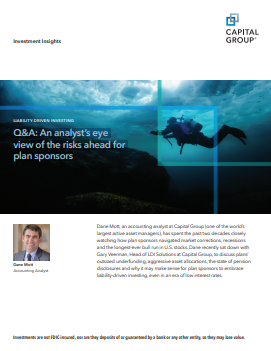In observance of the Christmas Day federal holiday, the New York Stock Exchange and Capital Group’s U.S. offices will close early on Tuesday, December 24 and will be closed on Wednesday, December 25. On December 24, the New York Stock Exchange (NYSE) will close at 1 p.m. (ET) and our service centers will close at 2 p.m. (ET)
Next steps in pension risk management
Capital Group accounting analyst Dane Mott has spent more than two decades assessing corporate pensions. He recently sat down with Gary Veerman, head of LDI solutions, to discuss key pension risk management issues that plan sponsors are facing today. In the first video of a three-part series, Dane and Gary discuss how plan sponsors can manage risk in an environment of low interest rates and rising premiums at the Pension Benefit Guaranty Corporation, and when it can make sense for a company to issue debt to fund a pension contribution.
Navigating low interest rates
Next steps in pension risk management
Pension contribution rules have loosened since the Great Financial Crisis. But that can reverse with shifts in the political winds. How do we view companies’ pension contribution policies and aggressive asset allocations in light of this risk?
Changes in U.S. accounting rules have limited companies’ ability to inflate operating earnings through pension smoothing mechanisms. What’s changed and how has the clarity of companies’ financial statements improved?
Gary Veerman: Hi everyone. My name is Gary Veerman and I lead the LDI solutions business at Capital Group. I’m joined today by my friend and colleague, Dane Mott. Dane works closely with our investors. His expertise is helping them dig deeper into the accounting of companies that we ultimately invest in. And pensions in particular are one of the areas of Dane’s expertise and today we’d like you to better understand ultimately how we look at those companies’ pensions when making investment decisions for our clients. Dane, great to have you with us today.
Dane Mott: Hey Gary, it's great to be with you.
Gary Veerman: So Dane, many pensions continue to put off increasing their hedge ratios, and many of them give the reason of low historical interest rate levels. What would you say to a sponsor that continues to wait for rates to move higher before adding to their LDI program?
Dane Mott: You know, I’ve been covering pensions for about 20 years now, and I’d say for my entire career, this has been a constant theme. People talking about what they’ll do with their pensions once interest rates go higher. And you know what that ultimately is is a market timing strategy, and you know, there’s a lot of academic research that indicates that market timing strategies don’t always perform well. I think it’s helpful to have some context about what has happened to pensions over the past 20 years. If we looked at the median discount rate for pension plan in 2000, it was 7.5%. If we fast forward to 2020, the median discount rate for pension plans was 2.5%. So, we’ve seen a 500-basis-point decline in discount rates over that time period.
Dane Mott: So, you know, if someone’s waiting for interest rates to go higher and if they’ve been somebody who’s been doing that throughout my career, if you were someone who is saying that to me in 2000, the reality is that you’re still waiting. My comment here is just to be careful with market timing strategies. If LDI or some kind of risk mitigation strategy makes sense for a company, I wouldn’t necessarily be waiting for a particular interest rate environment to do it. De-risking can help a plan regardless of market environment.
Gary Veerman: Yeah Dane, those are all phenomenal comments, and when we engage clients, we talk to them about effectively interest rates being an uncompensated risk for the pension plan. So, certainly aligned with the conversations we’re having and also some momentum for clients to consider adding to those LDI allocations.
Gary Veerman: Engaging pension clients today, we still run across a number of plans where their funded deficit is fairly significant. Dane, can it make sense for these companies to issue debt to make a pension contribution? What other factors do you think a company’s management needs to consider if they go down this path?
Dane Mott: Thanks Gary. It’s a great question. You know, I avoid making kind of blanket statements about the capital allocation decisions that managements should make, but I think in some situations, a debt-financed pension contribution could make sense for companies. One of the factors that I think a management team will have to consider is the Pension Benefit Guaranty Corporation’s variable rate premium rising to 4.8% in 2022. So, if you’re a company that’s making that choice between raising debt at some interest rate, or maintaining this underfunded status, and still having to pay this 4.8% insurance premium to the PBGC, some companies might find it more attractive just to raise the debt, improve the funded status, shore up the pension, which communicates something to investors. It communicates the pension is healthy and that investors can focus more on the business. And then perhaps in some cases, maybe they’re getting that debt at an interest rate that’s comparable or less than that 4.8% insurance premium.
Dane Mott: So, those are some considerations. The other thing I would just mention was in the early 2000s there were a number of companies that went out and raised a lot of debt to fund their pensions and they did not de-risk. They did not move to LDI and things like that. They stayed in aggressive asset allocations and that ended up to be very costly for them. Because they raised the debt and they’d be responsible for funding that debt over the number of years, but then the pension assets didn’t perform well when we got into the Great Financial Crisis. So, some of them found themselves in a situation where essentially they were paying that obligation twice. They still had to pay the debt, but they lost a lot of the assets through poor asset returns and were eventually going to just have to make future contributions to the PBGC to close their funding gap.
Dane Mott: So the message there is just, if you do debt-financed contributions, think about opportunities to de-risk and do things that are less aggressive with those debt-financed assets.
Gary Veerman: Amazing, Dane. Ten years ago, we were looking at variable rate premiums of about 1%, so now at 4.8%, you’re looking at almost a 5% interest cost on any unfunded deficit. So that alone at least should raise the question to companies around potentially debt financing, and contributing to the plan. Thank you for your comments.

Dane Mott is a global accounting analyst with 22 years of experience. Prior to joining Capital Group in 2015, Dane was an accounting analyst at his own firm, Dane Mott Research LLC, and at J.P. Morgan and Bear Stearns. He holds an MBA and a bachelor’s degree from New York University. Dane is a CFA charterholder and a certified public accountant.

Gary Veerman is head of LDI solutions at Capital Group. He has 21 years of industry experience and has been with Capital Group for four years. Prior to joining Capital, Gary was managing director and head of U.S. LDI solutions at BlackRock and head of LDI strategy at Legal and General Investment Management America. Before that, he was director of asset allocation research at Rocaton Investment Advisors. He holds a master's degree in global financial analysis from Bentley University and a bachelor's degree in business administration with a concentration in finance from West Virginia University.
Years of experience as of December 31, 2021

An analyst’s eye view of the risks ahead for plan sponsors
Accounting analyst Dane Mott explores pension funding, aggressive asset allocations, and why it may make sense for plan sponsors to embrace liability-driven investing, even in an era of low interest rates.
Connect with our liability-driven investing team.
Our dedicated LDI Solutions Team has experience in pension plan risk management across assets and liabilities and can help address your plan’s unique needs.